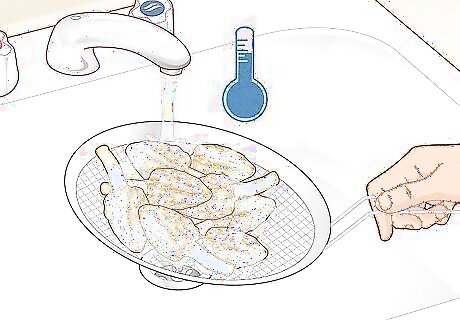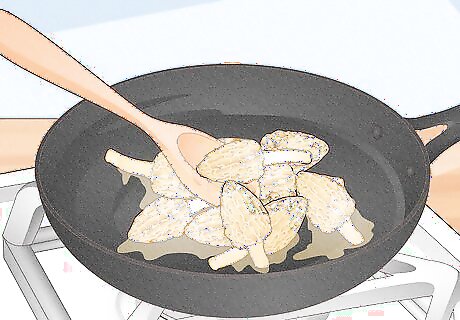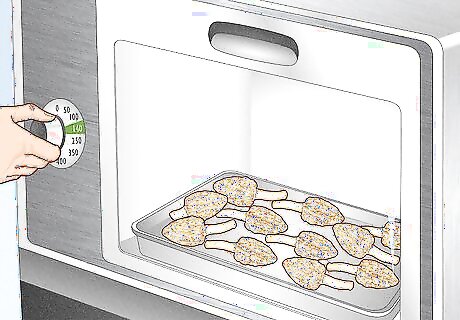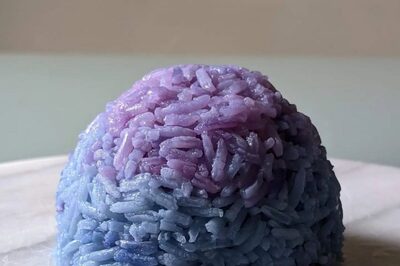
views
Storing Morels in the Fridge

Sort through the morels and choose ones that are firm and springy. The morels should feel plump—you don't want mushrooms that are starting to dry out or mushrooms that feel slimy. You should also toss any mushrooms that are bruised or feel mushy since they won't store well.

Loosely store the morels into a paper bag for quick access. If you know you're going to be cooking and eating the morels within a day or two, put them into a paper bag and store them in the fridge. The paper bag allows good airflow around the mushrooms, so they won't turn slimy. If you want, you can wipe them with a dry paper towel before storing.

Wrap the morels in a paper towel for a bit more protection. This is another option if you're worried that the morels will get jostled in the fridge. Just wrap the mushrooms loosely in a paper towel and pop them into a bowl or a plastic bag. Don't cover the bowl or seal the bag, and plan on cooking the morels within a couple of days. The paper towel around the mushrooms will absorb some of the moisture. However, if you seal the plastic bag, you'll trap moisture in the bag with the morels, and they'll spoil more quickly.

Clean the morels only before eating. If the morels aren't terribly dirty, rinse them with cool water and dry them completely. If they're pretty dirty, soak them in a bowl of cold saltwater for up to 30 minutes and rinse them well. If you wash the mushrooms and refrigerate them, the moisture will cause them to spoil a lot faster. There's a lot of disagreement among morel hunters about the best cleaning method. Some argue that rinsing is all you need since saltwater could affect the taste of the morels. Others point out that saltwater is the only way to get all the grit and tiny bugs out of the crevices.
Cooking and Freezing the Mushrooms

Wash the morels in cold water and trim the ends. Discard any slimy mushrooms and thoroughly rinse the firm ones in cold water to remove dirt and grit. Then, take a small knife and trim off the end from each stem. If the morels are wider than 1 inch (2.5 cm), slice them or cut them into quarters.

Sauté the morels for rich flavor and the best texture. If you simply freeze morels without par-cooking them first, they'll have a softer, mushier texture. For the best flavor, sauté the mushrooms with butter or oil for 3 minutes. Then, let the sautéed mushrooms cool completely. Feel free to use your favorite cooking oil like walnut oil, sunflower oil, or coconut oil.

Steam the morels to preserve their color. If you want the morels to keep their pale or light brown color, go with steaming instead of sautéing. Mix together 2 c (0.47 L) of water and 1 teaspoon (4.9 ml) of lemon juice or 1 1/2 teaspoons of citric acid. Soak the mushrooms in the solution for 5 minutes. Then, steam the mushrooms for 3 to 5 minutes. Lemon juice and citric acid contain enzymes that prevent browning. Note that steamed morels will keep longer than morels that are sautéed in butter or oil.

Freeze the mushrooms individually before long-term storage. Spread the morels on a baking sheet and freeze them for 2 hours. Then, transfer the frozen mushrooms to a sealable container that you can stick in the freezer. If you're using a jar or rigid container, leave some headspace for the mushrooms to expand. Freeze the morels for up to 1 year. It might be tempting to toss all of your morels into a bag and stick it in the freezer, but they'll all freeze in a big clump. This is why it's better to freeze them individually on the tray first. Don't forget to label your freezer container with the contents and the date—this way, you know to use the morels within a year. To defrost the frozen mushrooms, just transfer the container to the fridge the night before you want to cook your morels. Unlike dehydrated mushrooms, you don't need to soak them in water before cooking them.
Dehydrating Morels

Clean the mushrooms before you dry them. If the morels aren't very dirty, rinse them with cool water and dry them completely. However, if dirt and tiny bugs are trapped in the crevices, soak the morels in a bowl of cold saltwater for up to 30 minutes and rinse them thoroughly before you dry them with a towel. Some morel hunters argue that a long soaking period will affect the flavor of the mushrooms.

Spread your morels on dehydrator sheets and dry them for 8 to 10 hours. Set your dehydrator to 110 °F (43 °C) and dry the morels until they're completely brittle. To test if they're done, try to snap one in half between your fingers. If it stretches instead of breaks, the mushrooms need more drying time. You can leave the morels whole or slice them.

Dry morels in the oven if you don't have a dehydrator. Turn your oven to its lowest heat setting and spread morels on a baking sheet. Arrange them so they're in a single layer and there's space between them. Then, slide the sheet into the oven and leave the door partially open. Dehydrate the morels for 8 to 10 hours or until they're brittle. Ideally, set your oven below 140 °F (60 °C). If you can't turn it that low, use your oven's "warm" setting.

Store them in an airtight container at room temp or in the freezer. You can keep the morels at room temperature for up to 6 months but they will lose some of their flavor the longer they're stored. For longer storage, put the container of dehydrated mushrooms in the freezer where they'll keep for up to 1 year without a loss of flavor. To rehydrate dried morels, soak them in a bowl of cool water for 10 to 20 minutes or until they're soft.



















Comments
0 comment